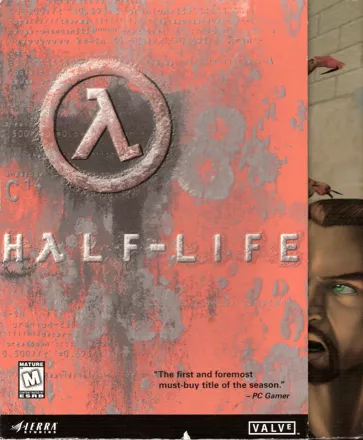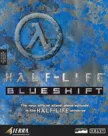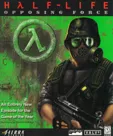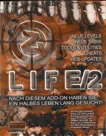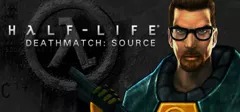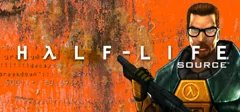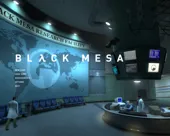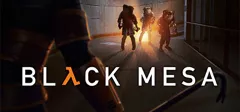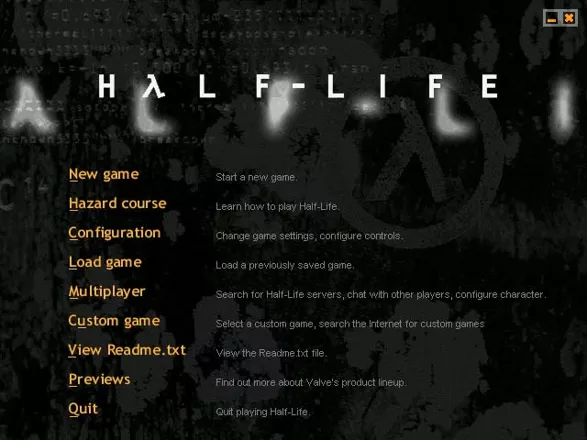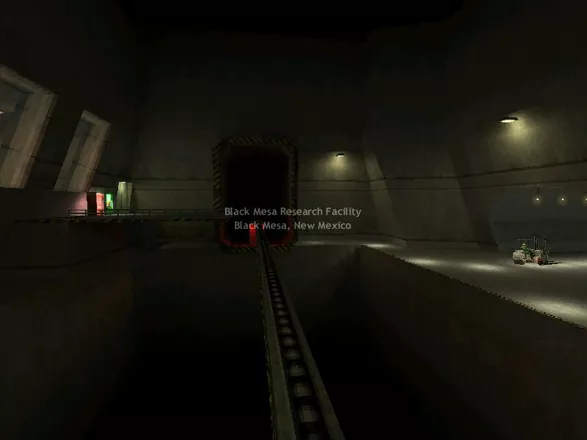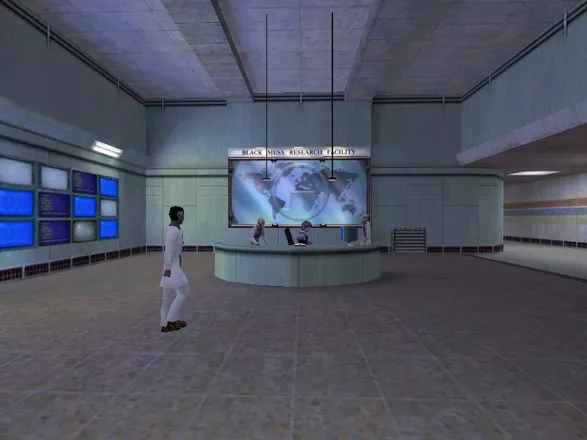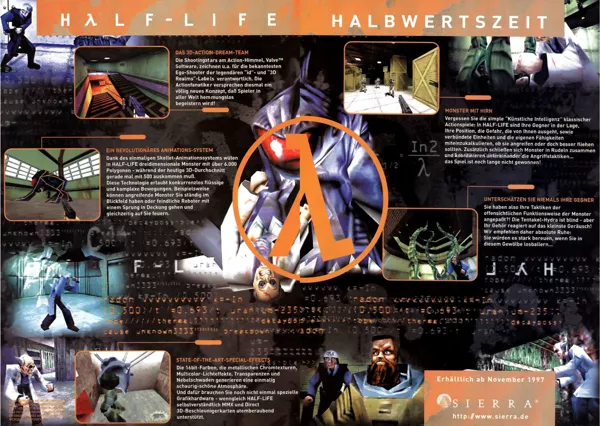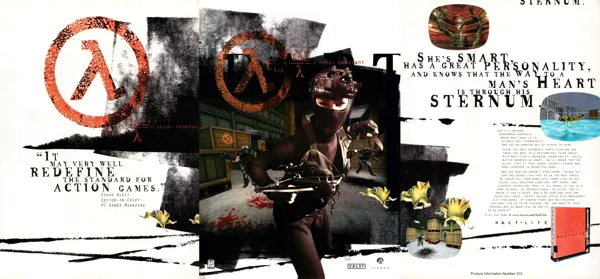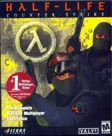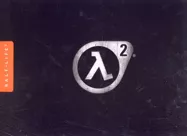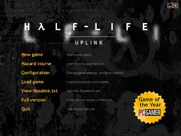Half-Life
-
 Half-Life
(2001 on
PlayStation 2)
Half-Life
(2001 on
PlayStation 2)
Description official descriptions
The Black Mesa Research Facility is an ultra-secret laboratory under a government contract to conduct top-secret and extremely volatile experiments. The scientist Gordon Freeman is a Black Mesa employee. One morning, as usual, he pits his way to the research facility for a run-of-the-mill experiment. However, Gordon comes to realize that it might not be as ordinary as he thought. Odd things happen as he makes his way to one of the Black Mesa test chambers. Even stranger things happen when he begins to move the test sample towards the anti-mass spectrometer.
At that moment, everything goes horribly wrong. Aliens from the dimension Xen suddenly invade the facility, injuring or killing many of the employees. Soon afterwards, marines arrive to contain the situation by killing the aliens as well as the surviving human witnesses. Gordon understands what that means: he will have to fight his way through both aliens and marines to get to the top of the Black Mesa complex and to freedom.
The story of Half-Life is told entirely in-game: everything is seen through the eyes of the protagonist. Most story elements unfold via scripted sequences, triggered by the player reaching a certain area. If other characters have information to reveal, they address Gordon directly. The Black Mesa complex in the game is made up of both distinct levels which progress in a linear fashion as well as hubs where backtracking may be required to unlock further areas.
The game's weapon arsenal mostly consists of realistic weapons like pistols, machine guns and explosives, but there are also futuristic energy weapons developed at Black Mesa as well as organic weapons acquired from the invading aliens. Most weapons feature an alternate firing mode.
Enemies fall into two categories: aliens and human soldiers. While most of the aliens are not very bright, the humans display some relatively advanced artificial intelligence: they seek cover, retreat when hit and try to drive the player from his cover by throwing grenades. Some of the alien enemies cannot be killed by normal means. The environment must be used against them instead, going with a general tendency of the game to alternate the combat with environmental puzzles.
As of the 25th Anniversary Update from 17 November 2023, the Steam version of Half-Life includes content from Half-Life: Uplink as well as sprays and maps from Half-Life: Further Data V.1.
Spellings
- 半条命 - Simplified Chinese spelling
- 戰慄時空 - Traditional Chinese spelling
Groups +
- 3D Engine: GoldSrc
- BestSeller Series (Cendant / Havas / Vivendi Universal) releases
- BPjS / BPjM indexed games
- Gameplay feature: Drowning
- Games referenced in movies
- Games with official modding tools
- Games with officially released source code
- Half-Life universe
- Middleware: SDL
- Setting: 2000s
- Setting: Future now past
- Weapon: SPAS-12
Screenshots
Promos
Videos
See any errors or missing info for this game?
You can submit a correction, contribute trivia, add to a game group, add a related site or alternate title.
Credits (Windows version)
80 People (58 developers, 22 thanks) · View all
| Engine Programmer | |
| Engine Tools Programmer | |
| The Half-Life Team | |
| [ full credits ] | |
Reviews
Critics
Average score: 94% (based on 59 ratings)
Players
Average score: 4.3 out of 5 (based on 536 ratings with 30 reviews)
The Good
I honestly don't know how everyone can be wrong about the exact same thing, but I suppose that's how you kill an American president back in the 1960's. I read over and over again that the best thing about Half-Life is the story. Well, it's a very average story: something goes wrong at a top secret facility and it's up to one guy to save the world from an alien invasion, even though the government tries to stop him. If you disagree, then what point could you make that would spoil the story? You can't , because the plot is paper thin. It's not like someone is someone's father, one someone is actually a ghost, or that someone you didn't think was a dude is actually a dude!! See, those are meaty stories, some with more meat on the bone than others.
Now, what it excels at is how to tell the story. By only using your protagonist's POV the entire story you are witness to how this common sci-fi story could play out practically in the real world. Gone are power-ups that spin around in mid-air. If you find weapons there is a reason why that weapon is there, as in being in a weapon lock up or near the body of a fallen soldier. Basically it's taking a movie and filling in all of the blanks when the camera isn't there to explain what happened. How did he get back to full health? Oh, he crawled around in back through the air ducts and so on. This idea of logic adds to the plausibility of the story, and thus our immersion into it.
Having every area bumped into smaller areas to facillitate numerous yet very short load times makes the game into basically one level that just continues on and on. But where Half-Life succeeds is in it's use of set pieces that punctuate the flow of this one, long level and makes the game memorable. So there isn't the dam level, or the commando assault on the surface level, or fighting the helicopter level; instead you remember it for the set piece and not a level, something that increases your immersion in this game greatly.
Immersion is important because the game attempts to let you experience all the things you'd ever wanted to do in games (or life, if you're really ambitious). Fight commandos, helicopters, tanks (I'm not sure, I finished the game half a lifetime ago), use homing RPG's... immersion makes the experience much more visceral, and therefore a much better gaming experience.
Another thing I found great about this game is how you identify with this guy, faceless save for the box art or any fan pic in which he is always holding the crowbar. By making him late in the beginning of the game and giving him the option of turning on the security alarm in the reception area makes him a guy like you and me; even though he works at a top secret government facility, it's crappy!
The Bad
Even though it tells the story well it really doesn't make much sense. So who is this G-Man guy? Why is he always behind bulletproof glass? How can this Gordon Freeman guy be late for work in the beginning and in the end be taking down highly trained extremely dangerous army operatives? Doesn't it cost a fortune to run (and clean) Black Mesa? Isn't it so big that you can see it from outer space, let alone at the side of the oad that borders it?
For Half-Life to be true Gordon Freeman has to be running from one coincidence to another, and in the end it's just too many: in Half-Life one guy saw/caused the beginning of the invasion, keeps running into the mysterious G-man, and in the end travels to another dimension. See, if there were cut scenes and some invisable camera was watching secret proceedings that weren't privvy to common knowledge then you can accept that. This device hurts the believability of the game, and as such the story. In that case, how can the story "rock"?
The NPC's really weren't that thrilling (unlike DOOM3, there aren't any Asians around waiting to be turned into zombies). Really they're just there to spout some exposition and then open a door. Back in the day on planethalflife there was a section called the Scientist Killing Club; this inspired me to play through the game again, only this time I would try to kill as many "innocent" NPC's as I can. You know, once they open a door you can kill anyone you want. What kind of story is that? That just means the NPC's role in Half-Life are really not that important.
It is too bad about the last third on Xen. I would have appreciated a shorter but better game. I think this is a case of making it longer just to satisy the common consumer and also making it harder just because you are getting close to the end. 2D platformers are 2D because they work well in 2D. I think with a well-thought out first and second half you're bound to be let down at the end. By the way, I've done both choices, but for what? The game ends either way.
The Bottom Line
Half-Life is worth playing but not worth worshipping. Games matured a bit with Half-Life, but this is definitely not a "thinking man's shooter" by any account. In retrospect Half-Life doesn't deserve all of the acclaim it received for its time, but then people thought Half-Life had an amazing story because people hadn't ever been told a story that well through a FPS.
It's funny that the one game that influenced Half-Life the most, DOOM, will then rip it off Half-Life in DOOM3: arriving late, being witness to the "resonance cascade", jumping through portals, and even another monorail ride!
In truth, it was unicorn b lynx who got me really thinking about games and also prompted me to get involved on this site, so it's all your fault. Myself, I got tired of reading "pwns" and "rox!" and "suks!"
Windows · by lasttoblame (414) · 2007
The average shooter on rails with wonderful PR
The Good
If there is anything good to say about Half Life, it is this: weapon feedback. Half Life is first and foremost a shooter, it is your method of interacting with the world, and for the most part, the weapons look solid, feel solid, and sound quite good. The weapons were varied but kept well with the theme of the game and were placed logically, and just as you needed them. Specifically the .357, the shotgun and the gaus cannon provide great feel, sound, and do a good job of killing your enemy.
Half Life flows well from one region to another, with quick loading transition spots that are barely noticeable, save for a subtle change in the lightmap on occasion. You move through several environments which are mostly labs, warehouses, utility centers and the outdoors, along with an alien environment. Half Life does deliver in giving a sense of physically moving from one place to the other.
Memorable moments can be had a few times, particularly the Ichthyosaur and the encounter with the Tentacle in the missile silo, along with much smaller scenarios.
The world is fairly detailed with mild touches reminiscent of Build era games, details like the microwave in the waiting room which can have the power go up higher and higher, until it ruins a meal, and the soda machines which produce cans.
The Bad
Half Life fails mostly on where they claimed their strengths to be. It is billed as the thinking man's shooter, yet there is little thinking required, merely trial and error. You are guided through the entire game on a mostly linear path, where every action you take, save a few exceptions, is required to progress, if it is the wrong action, you are punished by an arbitrary obstacle, or worse, pain or death. Every puzzle encountered, every scripted event, every new weapon and every enemy is placed in such a way that you have to find it then and there, and every other player of the game experiences it in the same order with the same effects. There is no way to own your experiences in Half Life as it can be adequately followed with a walkthrough.
Half Life's storyline is that of Doom's, only with marines coming in as a third party. Scientists tinker with technology, a portal appears and aliens invade, however instead of military being on base to help stop it as in Doom, they come in later and do a cover up. The only true spin on this is that you play a scientist and thus must face both groups. At first it is cool to see marines duking it out with aliens, but replaying scenarios reveals that due to the low level of variance in the ai, it usually turns out exactly the same. Half Life in terms of story plays like Doom where the former marines are instead current marines, and you have to sit through cutscenes (true you never stop being able to move, but you're locked into an area for the duration of an NPC speaking).
Half Life is a cold world, the NPCs have little personality and do little to garner sympathy, in comparison with Unreal's nali, or in opposition the civilians of Blood 2 which are actively made to be disliked. The NPCs serve mostly as mobile keys for the typical locked door.
The artificial intelligence is superficial, but looks great at a glance. Marines seem to take cover and seem to want to live, until you realize that they behave nearly the same regardless of your approach style. It is rewarding to toss a grenade at a group of soldiers and hear them scream "Grenade!" and duck, but the ducking seems to happen regardless of the grenades position, and Ive successfully taken out a squad with a single grenade, as they all ducked right around it. Half Life's ai can be summed up with being on par with Quake 2's in the use of basic breadcrumbs, and stylized with scripted events.
The level design though linear was fairly solid, up until Xen, the alien planet which functions mostly as a jumping puzzle with nuisance enemies. Throughout the game the levels serve mostly as a way to kill time until the next scripted event by mowing down mindless Vortigaunts and Headcrabs.
Lastly, who coded this interface? Half Life seems to be using an external program for its menu, which leads to a lot of mode switching for your monitor. And what for? The mouse driven interface? I really don't understand why it was done this way, and it makes it a chore to do simple things like changing your controls or looking at your saved game list.
The Bottom Line
On the whole Half Life is a basic shooter that attempts a cinematic quality by playing to the weakness of cinema - linearity and lack of input. It is a decent first play through which loses itself as you move forward. Good for $10, but not for the awards it has received, and definitely not the original retail price.
Windows · by David Queener (6) · 2007
Pleased to make your acquaintance Mr. Half-Life, but haven't we met before?
The Good
Interesting weapons with good variety, great sound and graphics, some impressive stages and good ballistics for an arcade game. Also there's great interaction in the game and there are some truly excellent action sequences, like a whole episode where you are on a little train and one where you have to sneak past a giant tentacle. The game also can create one hell of an atmosphere.
The Bad
Well, the npcs look like the same two guys all through the game, and the AI in the game looks amazing, but that's because it merely follows some clever pre-programmed steps, you'll quickly learn it's "holes" and how to take advantage of them. Also the final boss sucks, it is merely a puzzle-like exercise with zero challenge to it.
But the real bad thing in Half-Life is that it is completely over-rated. Half-life is a great game, but let's not confuse the issues, that doesn't mean it does anything new or innovative, it merely does everything we have seen before better. For instance, the storyline is a piece of crap, it's the usual "bad aliens come to kick ass" thing but updated to our current times (cue in the government cover-ups and X-files references). Why does it seem better then? Because it is made a part of the game. In previous games you played through a level/mission and then you sat back to watch the story unfold in cutscenes, on Half-Life the story unveils before your eyes in the game!! Revolutionary you say? I say System Shock, just because it's the first one that comes to mind. The gameplay itself is also unninspired, and shows the true nature of the game, for instance: take the giant tentacle sequence: what's it really about? flipping switches, and shooting anything in the way... However by lots of inventive designs and atmosphere tricks, we get duped into thinking it's actually a deep non-linear affair, millions of times I was fooled into thinking "wow, there must be hundreds of possible ways to finish this game" Wrong, Half-Life is a shooter pure and simple, and though it may seem deep it is actually Doom Redux: kill everything in the room, flip the switch, move on... ad infinitum.
As such, it is very easy to understand the reason Half-Life is so successful. Half-Life is nothing but a sophisticated Doom, yet everyone hails it as the next coming in terms of level design, storyline, etc... Don't get me wrong, like Doom, I love Half-Life! But I know what the game is REALLY about.
In the end it is all about illusions really, you may say that I'm being overly cynical, and that illusions is what gaming is all about anyway.... but still, I can't help but think that the gaming industry can provide something different that just newer, better versions of Doom. I'd like to think that they can provide original storylines and true depth of gameplay instead of pulling quarters out of our ears, showing us a series of nifty tricks and making us believe we have had the time of our lives
The Bottom Line
To be fair let me state that Half-Life really IS an atmospheric rollercoaster ride to remember. It is one helluva game and I loved playing it. But does it deserve it's success? I can't help but feel outraged when people that have been in the business for years get the shaft because they refuse to do the same stupid things over and over and try to be innovative, while along comes Valve, rehashes Doom, and suddenly they get considered the next design gods of the century...
No, something must be wrong...
Windows · by Zovni (10504) · 2011
Discussion
| Subject | By | Date |
|---|---|---|
| Narrative, wait what? | Donatello (466) | Jul 15, 2012 |
| Sorry, Valve | xroox (3895) | Feb 12, 2009 |
Trivia
1001 Video Games
Half-Life appears in the book 1001 Video Games You Must Play Before You Die by General Editor Tony Mott.
Advertisement
Very early beta footage of the game, as well as interviews with some of the programmers, is available on the Diablo expansion pack Hellfire, released by Sierra a full year before the game ever shipped. Sierra already had advertisements for Half-Life in many of their products back then.
Cancelled ports
- Half-Life, at one point, was completely finished for the Dreamcast console. Prima (the Official Strategy Guide folks) even had a Dreamcast-exclusive guide published. Unfortunately, the game wasn't published - probably due to the fact that SEGA announced that they would no longer produce new Dreamcasts. In certain circles of the Internet, a leaked copy can still be found and ran on a Dreamcast.
- A Macintosh port was in the works from Westlake interactive and reached beta before being cancelled because of concerns about responsibility for tech support.
Development
In its first finalized form, as it would have been published if the original release date was kept, Half-Life was nothing more than a total conversion of Quake with new enemies and levels. In the one additional year spent on development the game transformed into the form that led it to critical and commercial success.
Engine
Half-Life was released a full year after Quake II and it's a common belief that it was based on the Quake II engine. This is not true. It is based on the original Quake engine and it's more than fair to say that it was modified beyond recognition by the Valve team. Amongst the additions were built-in 3D accelerator support, skeletal systems and shadow casting (the latter didn't make it into the game). Valve now refers to this engine as "GoldSrc". This is probably how the "Source" engine from Half-Life 2 got its name.
German version
There is a special German version which features robots as enemies, green blood instead of red and innocent people cannot be killed any longer. The robot design was outlined by Sierra's Germany division, then sent to Valve in Seattle, where the artists created and implemented the tin soldiers. The changes in the game's code and art, together with the text and speech localization, served to delay the German version by full four months. By then, even casual gamers had already purchased the original version, which was freely for sale up to its ban. However, Half-Life proved to be so immensely popular that the German robo-version still sold over 50,000 copies, so the venture was ultimately successful for Sierra.
On December 16, 1998, the US version of Half-Life was put on the infamous German index by the BPjS. For more information about what this means and to see a list of games sharing the same fate, take a look here: BPjS/BPjM indexed games.
Gina Freeman
Apparently, Valve had written a part for Gordon's wife, Gina, to appear in the game, this idea got scrapped but she still made it to the game, her model was the one used for the holographic trainer.
id Software
When id Software saw what Valve was doing with their engine, they were reminded of their original idea for a seamless, story-based DOOM and thought it would fail. It didn't.
Innovations
Half-Life was influential in many little ways, popularising several gameplay devices which have subsequently become standards, such as: * The between-episode text which appears, overlaid on the screen, before slowly fading out (adopted not just in other computer games, but in several different Linux windowing systems too) * A training segment which is presented as an integral part of the storyline * The practice of rendering cut-scenes with the in-game engine * Blood-splatters and other persistent stains * Semi-random NPC speech and 'interaction' in an otherwise straightforward action game * Weaponry which needs to be manually reloaded between magazine changes * Constant playflow: the levels directly connect to each other
Inspiration
According to Valve's Gabe Newell, originally Half-Life was inspired by Stephen King's novella The Mist. However the game evolved so much from the preliminary concepts that the only things that remained were the horror/technology combination and the designs for the Bull Squid and the blind tentacle.
Lambda
Half-Life's lambda symbol is not the scientific symbol for half-life, but is instead the decay constant in the differential equation for exponential decay. The actual scientific symbol used for half-life is t1/2.
Mods
Counter-Strike was not a freak occurrence. Valve made the game editor immediately available, produced the mod Team Fortress Classic as an example of a finished mod, and also sponsored "Mod Expos", events where modders could present their work to other gamers and the press.
Plot
According to planethalflife.com: "the material that makes up the three green triangles protecting Nihilanth is the same as the crystal sample which you pushed into the beams to start this whole mess in the first place. Valve Software originally intended to make this connection more obvious but never did."
References
- The security office is in sector 7G. Homer Simpson works in a sector with the same name.
- The Gluon Gun was nicknamed "The Egon" after the Ghostbusters Character Egon Spengler. The Gluon gun projects a plasma stream similar to the ones used by the Ghostbusters.
- The surnames on the lockers where Gordon goes to collect his HEV suit are of people from the development team. Gordon also has a book by Half-Life writer Marc Laidlaw in his locker.
References to the game
The game makes an appearance in season 1, episode 22 of Lost, a popular TV series. Some in-game action is shown, and the characters shortly discuss the use and the effectiveness of the crowbar as a weapon.
Remakes
- In 2004, Valve released a re-mastered version using Half Life 2's Source engine, called Half-Life: Source.
- In 2012, a group of fans released a remake of their own, called Black Mesa. The team's goal was to provide a completely new and more modern version of the original experience, since according to them, Valve's remake "didn't fully live up to the potential of a Source engine port of Half-Life". In fact, most of the game's content remained unchanged: Half-Life: Source mainly added new water and physics effects, but didn't upgrade the game's textures or character models.
Sales
As of 2007, the game sold of over eight million since its release. (source)
Shotgun
There's a minor technical error with the shotgun. It's presented in the game as a double-barreled weapon, and the alternative fire mode shoots two shells at half the speed. However, the shotgun is modeled on a single-barreled weapon, the popular Franchi SPAS-12, which appears in several computer games. What looks like a second barrel is actually the under-barrel tubular magazine, which holds the shells.
Sound engine
Half-Life was one of the first games to utilize a software-driven environmental sound engine. Effects are applied in context of room size and surfaces of reflection. Reverb effects are calculated in realtime and applied on the fly as sounds are triggered.
University of Innsbruck
In the game manual, the first two pages contain a fictional letter from the administrative offices of the Black Mesa Research Facility to Dr. Gordon Freeman, concerning his upcoming employment. The address on the letter indicates that Freeman was a visiting fellow at the Institute for Experimental Physics, University of Innsbruck, before moving to Black Mesa. In contrast to the common practice of using fictitious addresses for storytelling purposes, the listed address is actually real. As confirmed by the official university website, "Technikerstraße 25, A-6020 Innsbruck" is the real-world location of Innsbruck University's Institute for Experimental Physics.
Awards
- Computer Gaming World
- April 1999 (Issue #177) – Game of the Year
- January 2001 (Issue #199) – Introduced into the Hall of Fame
- March 2001 (Issue #200) - #1 Game of All Time (Readers' Choice)
- March 2001 (Issue #200) - #2 Game of All Time (Editors' Choice)
- GameSpy
- 2001 – #2 Top Game of All Time
- 2012 – #1 Top PC Gaming Intro
- GameStar (Germany)
- Issue 12/1999 - #17 in the "100 Most Important PC Games of the Nineties" ranking
- PC Gamer
- April 2000 - #1 in the "All-Time Top 50 Games" poll
- October 2001 - #1 in the "Top 50 Best Games of All Time" list
- April 2005 - #1 in the "Top 50 Best Games of All Time" list
- PC Player (Germany)
- Issue 01/1999 - Best Game in 1998
- Issue 01/1999 - Best Shooter in 1998
- Power Play
- Issue 02/1999 – Best Action Shooter in 1998
- Retro Gamer
- October 2004 (Issue #9) – #38 Best Game Of All Time (Readers' Vote)
Information also contributed by -Chris, Ace of Sevens, Adam Baratz, [Ashley Pomeroy](http://www.mobygames.com/user/sheet/userSheetId,1364/), [Chris Martin](http://www.mobygames.com/user/sheet/userSheetId,688/), [CrankyStorming](http://www.mobygames.com/user/sheet/userSheetId,184929/), [Emepol](http://www.mobygames.com/user/sheet/userSheetId,12364/), [Entorphane](http://www.mobygames.com/user/sheet/userSheetId,7266/), [Foxhack](http://www.mobygames.com/user/sheet/userSheetId,33543/), [Gargaj](http://www.mobygames.com/user/sheet/userSheetId,40955/), [Maw](http://www.mobygames.com/user/sheet/userSheetId,49554/), [MegaMegaMan](http://www.mobygames.com/user/sheet/userSheetId,45233/), [PCGamer77](http://www.mobygames.com/user/sheet/userSheetId,1717/), [phlux](http://www.mobygames.com/user/sheet/userSheetId,9660/), [Ronald Diemicke](http://www.mobygames.com/user/sheet/userSheetId,69660/), [Spartan_234](http://www.mobygames.com/user/sheet/userSheetId,64477/), [rstevenson](http://www.mobygames.com/user/sheet/userSheetId,1745/), [Sciere](http://www.mobygames.com/user/sheet/userSheetId,30979/), [Scott Monster](http://www.mobygames.com/user/sheet/userSheetId,35225/), [Silverblade](http://www.mobygames.com/user/sheet/userSheetId,48546/), [shifter](http://www.mobygames.com/user/sheet/userSheetId,1822/), [Xoleras](http://www.mobygames.com/user/sheet/userSheetId,42761/), [Zack Green](http://www.mobygames.com/user/sheet/userSheetId,9727/) and [Zovni](http://www.mobygames.com/user/sheet/userSheetId,3250/).
Analytics
Upgrade to MobyPro to view research rankings!
Related Sites +
-
Hints for Half Life
Question and answer type hints give you the solutions at your own pace. -
Planet Halflife
The usual 'planet' site for the Half-Life game. Lots of new maps, skins, addons etc. Together with the daily news ticker this makes a 'must-stop' for every Half-Life fan. -
The Final Hours of Half-Life
GameSpot writes about the last part of Half-Life's development. -
The Half-Life Saga Story Guide
A site devoted to detail the various events and lore in the Half-Life universe so far. -
The Official Half-Life Web Site
Wayback Machine snapshot from 2000
Identifiers +
Contribute
Are you familiar with this game? Help document and preserve this entry in video game history! If your contribution is approved, you will earn points and be credited as a contributor.
Contributors to this Entry
Game added by doj.
Macintosh added by Sciere. Linux added by Kabushi.
Additional contributors: Tomer Gabel, Adam Baratz, Unicorn Lynx, Jeanne, Zack Green, Apogee IV, Daniel Saner, Paulus18950, Cantillon, Patrick Bregger, Plok, lethal_guitar, MrFlibble, FatherJack.
Game added June 6, 1999. Last modified March 18, 2024.
